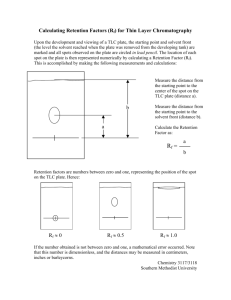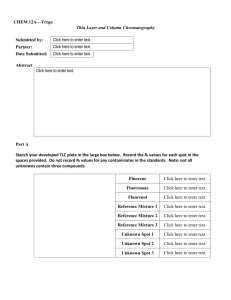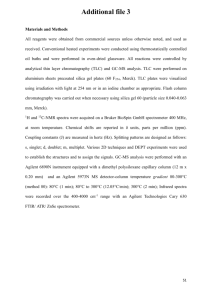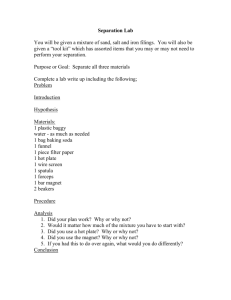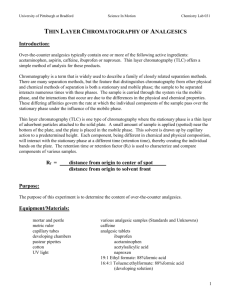Gas chromatograph
advertisement
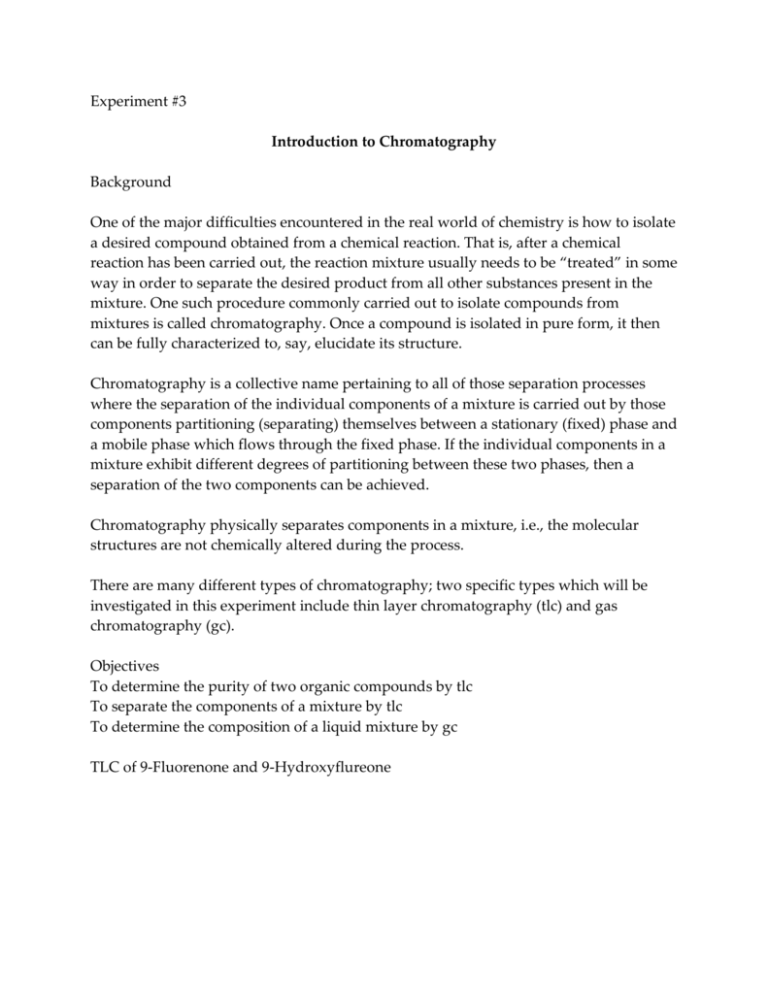
Experiment #3 Introduction to Chromatography Background One of the major difficulties encountered in the real world of chemistry is how to isolate a desired compound obtained from a chemical reaction. That is, after a chemical reaction has been carried out, the reaction mixture usually needs to be “treated” in some way in order to separate the desired product from all other substances present in the mixture. One such procedure commonly carried out to isolate compounds from mixtures is called chromatography. Once a compound is isolated in pure form, it then can be fully characterized to, say, elucidate its structure. Chromatography is a collective name pertaining to all of those separation processes where the separation of the individual components of a mixture is carried out by those components partitioning (separating) themselves between a stationary (fixed) phase and a mobile phase which flows through the fixed phase. If the individual components in a mixture exhibit different degrees of partitioning between these two phases, then a separation of the two components can be achieved. Chromatography physically separates components in a mixture, i.e., the molecular structures are not chemically altered during the process. There are many different types of chromatography; two specific types which will be investigated in this experiment include thin layer chromatography (tlc) and gas chromatography (gc). Objectives To determine the purity of two organic compounds by tlc To separate the components of a mixture by tlc To determine the composition of a liquid mixture by gc TLC of 9-Fluorenone and 9-Hydroxyflureone Directions Part 1 Your instructor will demonstrate the techniques involved in carrying out thin layer chromatography. Touch a tlc capillary tube to a solution of 9-fluorenone (an organic compound) dissolved in acetone and then touch this capillary tube to a silica gel tlc plate at postion A. See Figure 1. Part 2 Now use 9-Hydroxyflureone instead of 9-Hydroxyflureone spot the tlc plate at postion B. View the plate under uv light. Circle the spot and develop the plate in the silica gel/iodine chamber to visualize the spot. Part 3 Repeat the spotting procedure this time using a mixture of 9-fluorenone and 9Hydroxyflureone. spots in a silica gel/iodine chamber. Elute the plate in Solvent composed of 50/50 dichloromethane/hexanes. Mark the solvent front on the tlc plate as you remove it from the chromatography jar. View the plate under uv light and circle the spot(s) with a pencil. CAUTION: DO NOT look directly at the uv light!! Develop the plate in a silica gel/iodine chamber to visualize the spot(s). Figure 1 shows the sequence of steps involved in carrying out a tlc procedure. Part 4 Figure 2 shows a tlc plate containing two compounds (two spots). The retention factor (Rf) is a calculated ratio of the distance from the origin to the center of the spot divided by the distance from the origin to the solvent front. Different compounds have different Rf values and hence these values can be used to identify unknown compounds with known compounds by comparing the Rf values determined under the same solvent system. See Figure 2. The Rf value of each compound X and Y can be calculated according to: For compound X: Rf = b/a For compound Y: Rf = c/a where the distances are measured in millimeters with a metric ruler. Accordingly, calculate the Rf for each spot on the plate obtained from Part 3 and record on the data sheet. GC of an Unknown Mixture of Two Organic Liquids Directions Part 1 Your instructor will demonstrate how to carry out a gas chromatography (gc) procedure. Accordingly, choose an unknown “GC Liquid Mixture” and record its unknown number on the data sheet. Inject about five microliters of the liquid into column A of the gc. The number of peaks appearing on the chromatogram equals the number of components in the mixture. For each peak, a retention time can be calculated according to Figure 3, which shows a chromatogram having two peaks. The retention time for compound (peak) X is “a” while that for compound (peak) Y is “b.” Your instructor will show how retention times are calculated. Calculate and record the retention time for each peak from your chromatogram and record on the data sheet. Experiment #3 Data Sheet Name ________________________ TLC of 9-Fluorenone and 9-Hydroxyflureone Part 3 a. Rf of 9-fluorenone: ____________ ___ (show calculations) b. Rf of 9-Hydroxyflureone ____________ ___ (show calculations) Part 1 Sketch the paper chromatogram and record observations made: Part 2 a. Rf of spot #1: (show calculations) _______________ b. Rf of spot #2: _______________ (show calculations) GC of an Unknown Mixture of Two Organic Liquids a. Mixture #: _______________ b. Retention time of first peak: (show calculations) _______________ c. Retention time of second peak: (show calculations) _______________ d. Staple chromatogram to the back of this page.

